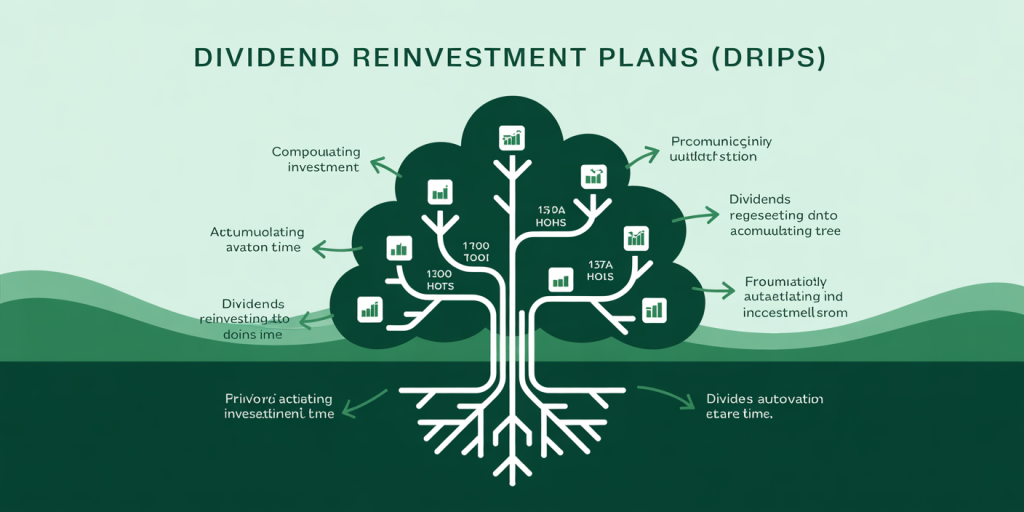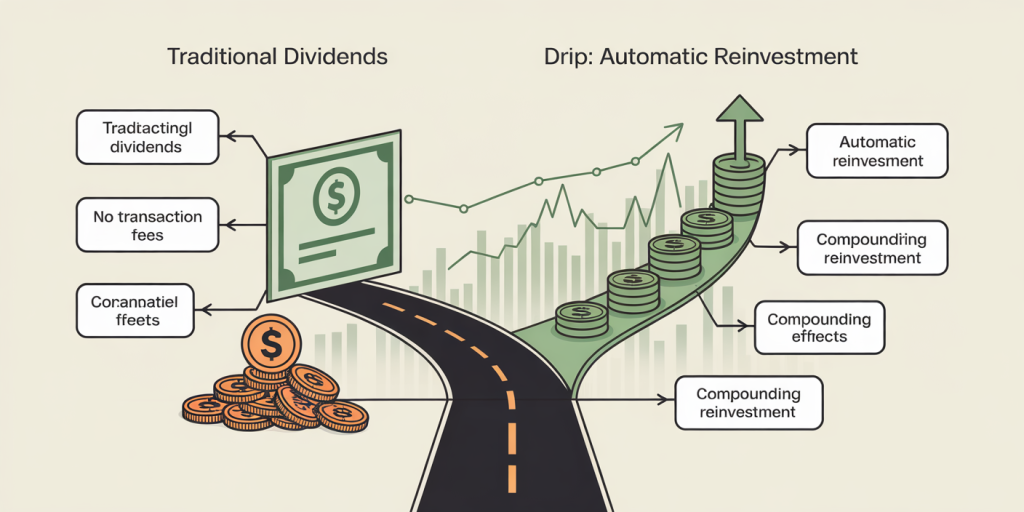Dividend Reinvestment Plans, commonly known as DRIPs, have become a favorite strategy among investors aiming for long-term wealth accumulation. This investment tool allows shareholders to automatically reinvest their dividends into additional shares of the issuing company rather than receiving cash payouts. Often overlooked by novice investors, DRIPs offer compelling benefits that can significantly enhance portfolio growth through the power of compounding and disciplined investing.

In this article, we will explore the fundamentals of DRIPs, highlight their advantages, provide practical examples, present comparative analyses with traditional dividend approaches, and discuss future trends that could redefine dividend investing.
—
What Exactly Are Dividend Reinvestment Plans (DRIPs)?
Dividend Reinvestment Plans are programs offered by corporations that enable investors to use dividends earned from their stock holdings to purchase more shares—or fractional shares—automatically. Instead of receiving checks or cash deposits, the investor’s dividends are applied towards the purchase of additional stock. This process happens without incurring brokerage commissions in many cases, making DRIPs an efficient way to accumulate more shares over time.
For example, if a company declares a $0.50 dividend per share and you hold 100 shares, you receive $50. Under a DRIP, that $50 would be used automatically to buy additional shares of the same company. Over months and years, these reinvested dividends snowball, increasing not only share count but also future dividend payouts due to higher ownership.
DRIPs are attractive to both income-focused investors and growth seekers. While dividend payments provide immediate income, reinvesting those payments harnesses the powerful effect of compounding returns. As a result, investors can grow their wealth exponentially over an extended horizon without needing to contribute additional funds.
—
How DRIPs Compare to Traditional Dividend Payouts
Many investors face an important decision: to take dividends as cash or to reinvest them through a DRIP. Below is a comparative table showing key differences between these approaches:
| Feature | Traditional Dividend Payout | DRIP |
|---|---|---|
| Dividend Use | Received as cash for immediate spending | Automatically reinvested into company shares |
| Transaction Fees | Potential broker fees when reinvesting | Usually no commissions or reduced fees |
| Compounding Effect | Limited if cash is spent | Significant long-term compounding |
| Share Accumulation | Limited to direct purchases | Incremental and automatic share growth |
| Investment Discipline | Requires manual reinvestment | Passive, consistent investment approach |
This table highlights that DRIPs remove friction in reinvesting dividends, which can otherwise deter investors from applying their dividends towards portfolio growth. In addition, companies that offer DRIPs often provide shares at little or no transaction cost, increasing the effective yield on dividend income.
—
Real-Life Examples Demonstrating DRIP Power
To understand the magic of DRIPs, consider historical case studies of companies with consistent dividend policies.
Coca-Cola (KO): Coca-Cola is one of the most celebrated dividend stocks. Its dividend growth rate averaged around 6-7% annually over the past decades. An investor who started purchasing Coca-Cola shares in 1980 and enrolled in its DRIP program would have seen their initial $1,000 investment grow to more than $1 million by 2020 by reinvesting dividends instead of withdrawing them. This phenomenal growth isn’t just due to stock price appreciation; the reinvested dividends buy more shares, which buy even more dividends, creating a snowball effect.

Johnson & Johnson (JNJ): Johnson & Johnson has increased its dividend payout for over 50 consecutive years. For a long-term investor, enrolling in the DRIP allowed continual share accumulation during market dips while capitalizing on compound returns. Historical data shows dividend reinvestment in JNJ added over 40% additional returns compared to taking dividends in cash over a 20-year horizon.
These examples underscore a critical point: DRIPs magnify the benefits of dividend investing, particularly for those in growth-oriented, dividend aristocrat companies.
—
Advantages and Potential Drawbacks of DRIP Investing
Advantages
One of the most significant advantages of DRIPs is cost-effectiveness. Many DRIPs enable investors to purchase additional shares without paying commission fees, unlike purchasing shares in the open market through brokers. Over time, avoiding these fees can translate into substantial savings.
Another benefit is the disciplined investing that DRIPs enforce. As dividends are automatically reinvested, investors avoid the temptation to spend dividend income impulsively. This “set-and-forget” approach helps build shares steadily, especially in volatile markets where timing the market is challenging.
DRIPs also facilitate fractional share investing. Most brokerage accounts require purchasing full shares, but DRIPs often reinvest dividends to buy even fractional shares, increasing precision in applying dividend income.
Potential Drawbacks
Despite the benefits, DRIPs aren’t without drawbacks. Investors may find tax implications complex when dividends are reinvested instead of paid out as cash. In many jurisdictions, dividend income is taxable in the year it is received, even if reinvested. This can lead to tax liabilities without corresponding cash inflows.
Additionally, DRIP investors tend to be heavily concentrated in a single stock. This concentration risk can potentially harm portfolio diversification, making it vital to balance DRIP strategies with broader asset allocation.
Also, DRIP shares accumulated over time may require record-keeping of the cost basis for tax purposes, complicating tax reporting especially when partial sales occur.
—
How to Choose the Right DRIP for Your Portfolio
Not all DRIPs are created equal. When selecting a DRIP, investors should consider several factors, including:
1. Company Dividend History: Focus on companies with stable or growing dividend payout records. Dividend aristocrats, or companies with 25+ consecutive years of dividend raises, are ideal candidates.
2. Program Fees: Investigate whether the DRIP imposes enrollment fees, service fees, or charges for reinvesting dividends. Zero or low fees are preferable.
3. Flexibility: Some DRIPs allow optional cash purchases in addition to dividend reinvestment. This flexibility can enhance new capital infusion directly via the plan.
4. Tax Documentation: Companies with clear and timely tax reporting can reduce the administrative burden of tracking reinvested dividends and basis adjustments.
Example: PepsiCo’s DRIP offers a user-friendly platform with no fees for reinvestment and allows optional cash purchases, making it a popular choice among retail investors. In contrast, some smaller companies may charge modest service fees but still offer access to shares at discounted prices.
—
Quantifying DRIP Impact Using Statistical Data
Research has shown that DRIPs substantially improve total returns over the long term. A study by the National Bureau of Economic Research (NBER) found that dividend reinvestment can add between 1.5% to 3% annually to total returns depending on market conditions and dividend yields.
For instance, between 1980 and 2020, the S&P 500 returned an average of approximately 11.7% per year, inclusive of dividend reinvestment. However, excluding dividend reinvestment significantly drops total returns, indicating that dividends and their reinvestment play a critical role in compounding growth.
Additionally, according to a 2022 report by Morningstar, actively reinvesting dividends improved average portfolio value by nearly 40% after 15 years compared to portfolios that took dividends as cash.
These statistics underscore DRIPs’ compelling ability to accelerate wealth building and outperform less disciplined dividend-taking strategies.
—
Future Perspectives: The Evolving Landscape of Dividend Reinvestment Plans
The future of DRIPs is bright and may undergo transformative changes as technology and investor preferences evolve. Digital platforms and fintech solutions have begun integrating DRIP functionalities directly into brokerage accounts, enabling investors to automate dividend reinvestments across diverse assets, not limited to direct company plans.
For example, modern robo-advisors now routinely offer automatic dividend reinvestment, blending ease of use with sophisticated portfolio rebalancing. This democratization means that even smaller investors can harness DRIP benefits without managing individual company plans manually.

Furthermore, emerging blockchain technologies promise enhanced transparency and reduced costs in dividend distributions and reinvestments. Smart contracts could automatically reinvest dividends into fractionalized shares in real-time with minimal intermediaries, optimizing investor experience and cost-efficiency.
Environment, Social, and Governance (ESG) investing may also influence future DRIP designs. Companies focusing on sustainability might pair DRIP participation with shareholder engagement initiatives, thereby aligning reinvested dividends with broader ethical goals.
Lastly, evolving tax laws around dividend income and reinvestment could encourage regulatory innovations to further incentivize DRIPs by reducing tax burdens on reinvested dividends, especially within retirement accounts or other tax-advantaged structures.
—
Dividend Reinvestment Plans provide a powerful yet simple investment strategy to grow wealth steadily over time through disciplined reinvestment and compounding. By understanding their benefits, drawbacks, and evolving features, investors can better leverage DRIPs as a cornerstone of their long-term financial planning. Whether starting small or optimizing a large portfolio, the magic of DRIPs lies in transforming passive dividend income into an accelerating wealth engine—creating opportunities for financial security and growth in an increasingly complex investment landscape.

Deixe um comentário